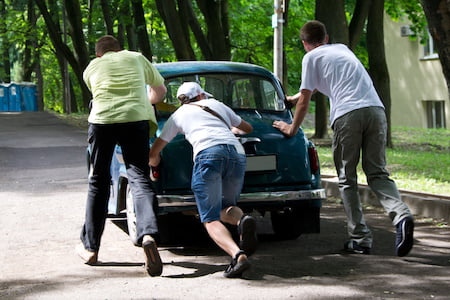Trouble Starting Your Car?
It’s a bright and early morning, the chirping of the birds sounds like beautiful music to your still groggy brain. You could as well be living in an urban setting and instead it’s the dog’s pitter patter on the floorboards that greets you in the morning. You get your kids and hurry your partner to get ready to leave.
You get in your car and thank the heavens you’re at least going to be a few minutes early today. You turn the key and the engine lets out a sound similar to a Tuberculosis patient in the Middle Ages. That little cloud you’ve been floating on pops into nothingness and you’re crashing back down to earth fast.
How could it? Your trusty car letting you down on this bright and wonderful morning? Et tu, vehicle?
Despite how much it feels like Brutus betraying Caesar, cars do break down, especially when they have not been undergoing regular maintenance. The problem, however, could be something that you could fix with some tools from your trunk or even your bare hands. In the worst-case scenario, you’ll have to call a trusty tow service for a jump start, but that’s where Santa Fe Towing comes in.
Common Reasons Your Vehicle Won’t Start
Let’s take a look at some of the most common reasons why your vehicle won’t start.
Dead battery
A dead battery is probably the most common reason for cars not starting after you’ve been away from them for some time. The battery works by providing the starter with enough voltage. The starter will then engage with the engine and crank it over. All this drains a lot of power from the battery.
A dead battery is mostly as a result of people leaving some form of electronics on in the vehicle. These mostly are headlights left on overnight, the radio left on. Other times, it could be as a result of the alternator not charging the battery.
Solving this problem will require the help of your neighbor. If you have two vehicles in your family, even better. All you need to do is grab jumper cables from one of the vehicles and attach them to both vehicles.
For this, both vehicles’ engines need to be switched off and the vehicles placed in park or neutral. Connect the positive terminals of both batteries using the red cable. They usually have bigger terminals. Connect the negative terminal on the other vehicle’s battery to an unpainted metal surface on or near your vehicle, far away from the battery.
The working car should start its engine and let it run for five to ten minutes. This will give your battery enough juice to crank over your engine. Let it run for 20 minutes as this gives your battery enough juice to start your engine the next time. If it still fails, then you will need to get another battery as yours can no longer hold charge or call a tow service for more help!
Bad Starter

Avoid pushing your car and call Santa Fe Tow Service if your car won’t start in Odessa, Missouri!As illustrated earlier, the start is the link between your car’s battery and the engine. They are an electric motor, and they use a basic principle of physics to achieve this. This makes them almost bulletproof and can last for years without needing replacement.
When you turn your ignition to the on position, a circuit is completed from the battery to the starter. The voltage will energize the electromagnet in the starter. This is turn pushes out a rod that will connect the starter to a flywheel on the engine crankshaft. The starter will then start to rotate, or crank, to get the engine pistons to start powering the engine by combustion.
The most obvious sign that something is wrong with your car’s starter is when you attempt to crank the engine and you get a click as feedback instead. The engine might also attempt to start but won’t.
A bad battery and bad starter have similar symptoms. To rule out the battery as the villain, simply turn on the headlights. If they do come on and are bright as they should be, then the starter is the problem.
When the problem is present but your car can start, quickly visit your service center to get it fixed. A bad starter can leave you stranded in bad conditions. If the car cannot start, you will need a towing service in Odessa to bail you out. In case you do, don’t hesitate to call Santa Fe Towing service.
No Gas
Yes, it does happen, and it’s actually more common than you think. Many people have called for a towing service before even checking the fuel gauge in their cars.
An empty gas tank could be just as simple as you forgot to fill up on your drive home the previous day. Just get some and start your vehicle. It could also be that you are experiencing a fuel leak. This is a much more serious problem that could lead to fires and damage, or total loss of the vehicle. Check under the car to see if there are any leaks.
One not so common problem could be a problem with the fuel pump and fuel filter. This could be because they are clogged from years of debris buildup. This results in very little fuel getting to the engine, which could see your engine’s performance suffering, or even completely refusing to start.
A faulty pump is also another reason. This could be as a result of a malfunction or just the usual wear and tear. Fuel pumps have been known to last for over 200,000 miles (321,868.8 km) but these are the exceptions rather than the norm. At around 100,000 miles (160,934.4 km), when you’re getting the other parts of the fuel system maintained, it would be prudent to have the pump replaced as well.
There could be many other reasons as to why your car won’t start. They could be things such as bad ignition coils, cracked, or even broken distributor caps (used to direct power from the battery to the spark plugs in the engine), or even timing belts that need repair.

